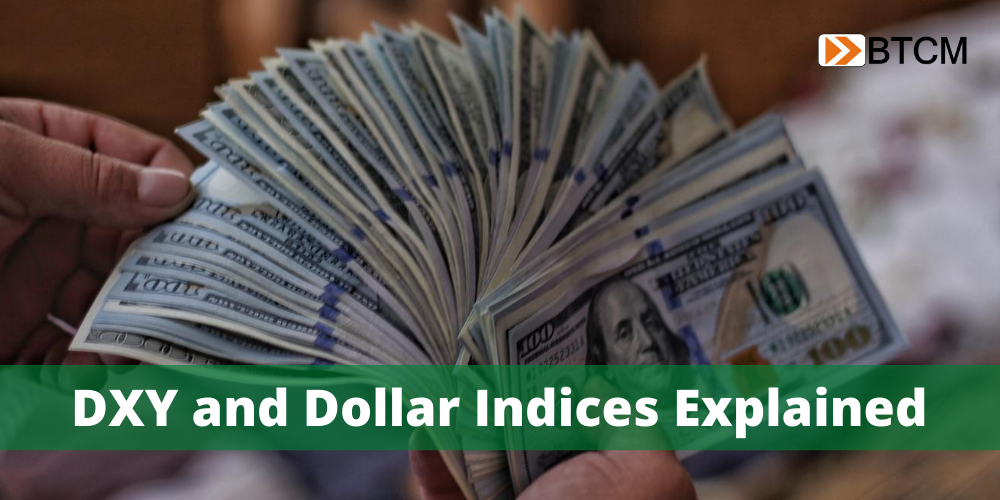DXY and Trade-Weighted Dollar Explained

Many pundits and commentators like to talk about the dollar strengthening or weakening, and they often site the DXY without understanding how it is constructed. In this post, we'll explain the history of the DXY, how it is formed, and how it is used today. We will also present important alternatives like the Federal Reserve's Trade-Weighted Dollar Index or Broad Index and Bloomberg's Dollar Index (BDXY).
The DXY Explained
The DXY (pronounced either D-X-Y or "dixie") is the ticker symbol for the US Dollar Index, a measure of the value of the US Dollar versus a basket of foreign currencies, first instituted in March of 1973 at a level of 100. It is by far the most widely used dollar index, primarily because it is the oldest and is a trade-able futures product by ICE (Intercontinental Exchange).
The history of the DXY begins shortly after the US left Bretton Woods and the gold standard in 1971. All the world's fiat currencies were floated against one another and, being on a de facto global US dollar standard, banks and investors needed a new metric by which to measure the dollar's strength and performance. A single weighted index is extremely valuable in foreign exchange markets.
Composition of the DXY
- Euro (EUR), 57.6% weight
- Japanese yen (JPY) 13.6% weight
- Pound sterling (GBP), 11.9% weight
- Canadian dollar (CAD), 9.1% weight
- Swedish krona (SEK), 4.2% weight
- Swiss franc (CHF) 3.6% weight
The DXY composition was forced to change in 1999 with the introduction of the Euro. But it didn't change much, all the previous European currency weights were rolled into the weighting for the Euro. That means the formula essentially didn't change, and has not changed since its introduction in 1973, back when it captured the trade and monetary relationships of the US. (For those interested, here is the original European currency weights, because it took awhile for us to find them. They have disappeared down the memory hole for the most part.)
- Deutsch Mark (DEM), 20.8%
- French franc (FRF), 13.1%
- Italian lira (ITL), 9.0%
- Dutch guilder (NLG), 8.3%
- Belgium franc (BEF), 6.4%
Problems with the DXY
The largest criticism of the DXY is that it no longer represents an accurate picture of US dollar trading partners. Over the years, the index became less relevant as a indication of strength based on trade but remained useful due to its relevance as a financial flow indicator. Even though emerging markets were a bigger part of global trade, especially China, US dollar financing was still primarily being done among the US, Europe, and Japan, all part of the DXY.
Even with it's new role as a indicator of financial flows, the DXY's usefulness continued to fade as the emerging markets rose initially in international trade and then in international finance, resulting in the DXY losing most attachment to actual dollar strength or weakness. Adding insult to injury, the interconnectedness and complex banking relationships between the US, Europe, Japan, and UK meant a deep understanding of financial markets was needed to interpret DXY signals. Movements of the dollar against the Euro or the Yen don't mean what they once did. Capital, credit, and currency relationships are blurred by derivatives and funding markets.
Despite all these drawbacks, the DXY is still very important because it remains the most widely used and traded dollar index.
Pros and Cons of DXY
Pros: (1) Liquidity of the futures product itself. Being a highly traded instrument makes it's price signal hard to ignore; this also means (2) its price feed is readily available on most charting websites.
Cons: (1) Lack of flexibility and completeness as a measure of dollar strength and weakness. The DXY is widely regarded as "mostly useful against the Euro and Yen", two very important currencies to be sure, but not a full representation of dollar dominance or value. (2) The DXY has never comprehensively updated it's formula. Even when the Euro replaced 5 of its currencies, the formula simply added them together. The global economy has changed drastically, and this old formula is not an accurate representation of the global economy.
What is the Trade-Weighted Dollar Index?
As the usefulness of the DXY as an economic indicator waned in the 1990's, the Federal Reserve created a more flexible dollar index called the Trade-weighted Dollar or Broad Index in 1998 to capture use of the dollar in international trade. Instead of only six currencies, this index weighs 26 currencies, notably including the Chinese Yuan, Mexican Peso, and South Korean Won. It is also regularly updated according to IMF trade statistics. The most recent update was in December 2019.
Trade-Weighted Dollar formula as of December 2019
- Euro Area - 18.947%
- China - 15.835%
- Mexico - 13.524%
- Canada - 13.384%
- Japan - 6.272%
- United Kingdom - 5.306%
- Korea - 3.322%
- India - 2.874%
- Switzerland - 2.554%
- Brazil - 1.979%
- Taiwan - 1.95%
- Singapore - 1.848%
- Hong Kong - 1.41%
- Australia - 1.395%
- Vietnam - 1.364%
- Malaysia - 1.246%
- Thailand - 1.096%
- Israel - 1.053%
- Philippines - 0.687%
- Indonesia - 0.675%
- Chile - 0.625%
- Colombia - 0.604%
- Russia - 0.526%
- Sweden - 0.52%
- Argentina - 0.507%
- Saudi Arabia - 0.499%
Pros and Cons of the Broad Dollar Index
Pros: (1) A better representation of the dollar use in global trade. (2) It does a decent job of capturing countries' overall relationships in the global economy; since the USD is the global reserve currency, a country's trade with the US is somewhat representative of their total economic activity. (3) The Broad Dollar Index is re-balanced periodically to retain accuracy of what it is supposed to be measuring.
Cons: (1) Lack of consideration for relative liquidity of currencies. China is a huge global trading partner, but the use of their currency is highly limited by strict capital controls. It is given a high weighting in the Broad Dollar Index but perhaps China should have a lower weighting. (2) It is not a trade-able product and consistently only available on the FRED website. Since it changes its composition periodically when weightings are included on popular charting websites, it is not long until the formula changes, resulting in a gap in availability.
Bloomberg Dollar Index (BDXY)
Introduced in 2004, the BDXY falls in between the DXY and the Fed's Trade-Weighted Dollar, both in number of currencies included and flexibility. The BDXY tracks the dollar versus the exchange rate of 10 other major currencies and is re-balanced each year according to Fed-reported trade flows and BIS-reported Forex liquidity. It is an interesting compromise, but falls just short of being a conclusive dollar measure, as well.
Bloomberg Dollar Index weights as of 2020
- EUR - 32.65%
- JPY - 14.64%
- CAD - 11.94%
- GBP - 11.49%
- MXN - 9.95%
- AUD - 5.15%
- CHF - 4.78%
- KRW - 3.43%
- CNH - 3.00%
- INR - 2.96%
Pros and Cons of the Bloomberg Dollar Index
Pros: (1) It tracks more currencies than the DXY, and (2) tracks those currencies in a more flexible manner. (3) It factors in liquidity, which is very important to getting an accurate representation of dollar strength and weakness.
Cons: (1) Proprietary, meaning access to real-time or slightly delayed quotes are available on the Bloomberg terminal only. It is also available on their market website but not conveniently accessible. (2) Still slightly overweight the Euro and underweight emerging markets. The Euro represents 32% of the basket while the three emerging markets included, Mexico, China, and India, only total half the Euro's weighting at 16%. Since the dollar standard is global, this measure is still slightly too US trade centric.




